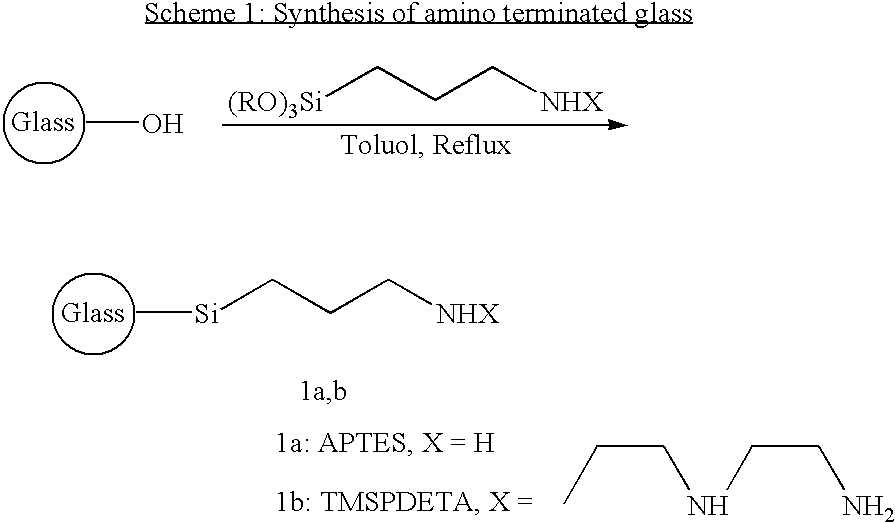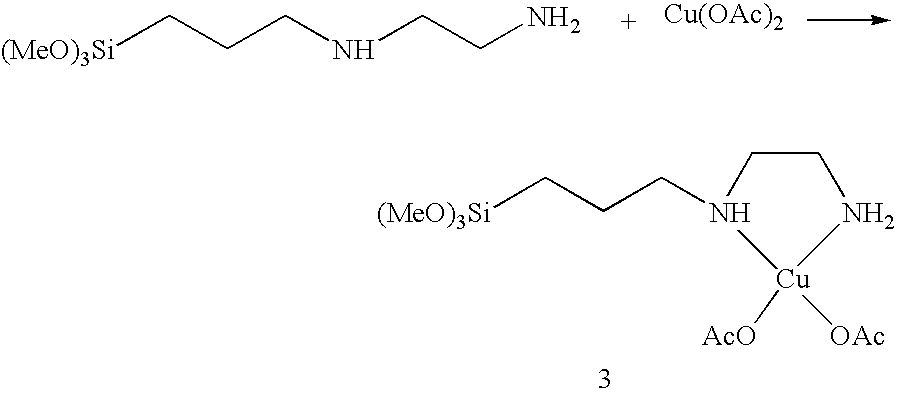Reactive filler for dental cements
a technology of ionomer cement and active filler, which is applied in the direction of dental prosthetics, transportation and packaging, impression caps, etc., can solve the problems of inability to apply ionomer cement in non-stress bearing areas, and inability to meet the needs of patients, etc., to achieve excellent working and setting times, improve compressive strength and flexural strength, and improve mechanical properties
- Summary
- Abstract
- Description
- Claims
- Application Information
AI Technical Summary
Benefits of technology
Problems solved by technology
Method used
Image
Examples
example 1
Immobilisation of Amino-Ligands on the Glass Surface
[0100]
APTES Silaneted Glass (1a)
[0101] To a suspension of 85 g of a predried strontium aluminosilicate glass in 200 ml of dry toluene was added 60 ml (56.9 g) of aminopropyltriethoxysilane (APTES). The mixture was stirred under reflux overnight and additionally stirred at room temperature for further 8 h to complete the reaction. The slurry was filtered through a suction filter and washed with 3×50 ml DCM, and 3×50 ml petroleum ether (40 / 60). Drying at 50° C. under 4 mbar yielded a slightly yellow coloured glass displaying pendant monoamino functions.
TMSPDETA Silaneted Glass (1b)
[0102] To a suspension of 85 g of a predried strontium aluminosilicate glass in 240 ml of dry toluene was added 60 g of (3-trimethoxysilylpropy)diethylenetriamine (TMSPDETA). The mixture was stirred under reflux overnight and additionally stirred at room temperature for further 8 h to complete the reaction. The slurry was filtered through a suction fi...
example 2
Preparation of Glasses Modified by Transition Metal TMSPDETA Complexes
[0103]
Copper Modified Glass (2a)
[0104] A slurry of 23 g of the TMSPDETA modified strontium aluminosilicate glass (1b) in 50 ml of MeOH was stirred with a solution of 34 mg of Cu(II) acetate in 10 ml of MeOH overnight at RT (room temperature). The glass was filtered over a P3-frit and washed excessively with MeOH (methanol) in order to remove any mobile metal ions. Drying at 50° C. for 24 h yielded a blueish-green coloured Cu(II) modified glass 2a.
Zinc Modified Glass (2b)
[0105] A slurry of 20 g of the TMSPDETA modified strontium aluminosilicate glass (1b) in 50 ml of MeOH was stirred with a solution of 20 mg of zinc acetate in 10 ml of MeOH overnight at RT. The glass was filtered over a P3-frit and washed excessively with MeOH in order to remove any mobile metal ions. Drying at 50° C. for 24 h yielded a slightly yellow coloured zinc modified glass 2b.
Lanthanum Modified Glass (2c)
[0106] A slurry of 20 g of ...
example 3
Preparation of GIC Formulations Containing Modified Glasses
[0111] Based on each of the above mentioned glasses modified by amine or transition metal complex, experimental ionomer cements were prepared and compared to a formulation containing untreated strontium aluminosilicate glass.
[0112] Experimental ionomer cements contain an experimental glass ionomer powder and an experimental glass ionomer liquid. The experimental glass ionomer powders contain 72% glass modified by amine or transition metal complexes and 28% of powdered polyacrylic acid. powders were mixed with an experimental glass ionomer liquid containing water (59%), PAA (32%) and tartaric acid (9%) in the ratio 3.7:1. These formulation were investigated with respect to their working time, setting time, compressive strength and flexural strength. The results are listed in the following Table 1.
TABLE 1FormulationF1aF1bF2aF2bF2cF2dF2eF2fF2gReferenceGlass contained1a1b2a2b2c2d2e2f2gUntreated glassWT [min]5.04.33.83.9ndnd3...
PUM
| Property | Measurement | Unit |
|---|---|---|
| Particle size | aaaaa | aaaaa |
| Particle size | aaaaa | aaaaa |
| Particle size | aaaaa | aaaaa |
Abstract
Description
Claims
Application Information
 Login to View More
Login to View More - R&D
- Intellectual Property
- Life Sciences
- Materials
- Tech Scout
- Unparalleled Data Quality
- Higher Quality Content
- 60% Fewer Hallucinations
Browse by: Latest US Patents, China's latest patents, Technical Efficacy Thesaurus, Application Domain, Technology Topic, Popular Technical Reports.
© 2025 PatSnap. All rights reserved.Legal|Privacy policy|Modern Slavery Act Transparency Statement|Sitemap|About US| Contact US: help@patsnap.com



